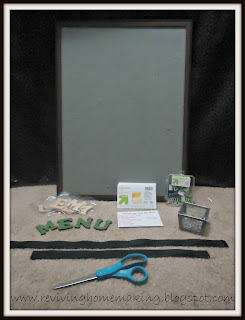 |
| Image Source: http://www.flickr.com/photos/reiner/331732019/ |
Welcome to the first post of the "DIY Dining Room Decor" series! Over the course of this week I'll be sharing five easy and budget-friendly projects to add to the organization, function and style of the dining room. Today we're going to focus on one of my favorite aspects of decorating- organization!
If you have been reading Reviving Homemaking even for a short period of time, then you will know that in our home we first prepare for weekly meals by menu planning. When we married and I began to figure out how to manage a home, I quickly decided that menu planning was a priority to learn. I could not tolerate coming home from a long day at college and/or work to be faced with the question of, "What should I make for dinner?" I would become so aggravated at needing to prepare a meal I didn't have the energy to do, didn't have all the ingredients I needed when I needed them (which prompted additional costly trips to the store), or gave up by going out to eat (which again, is very costly). The solution was menu planning.
For us, menu planning is all about knowing what we need to prepare meals and by when we needed it. I account for everything in our menu plans, including healthy and fresh snacks. I perhaps over plan, but I'd rather have good options available than to turn to junk foods or fast foods. There will be another post in the future on exactly how we've come to create our weekly menus, but for now I'm going to focus more on keeping those menus organized.
What's better than an area that is happily organized? Happy organization on display! In a previous post, I demonstrated how we were able to turn bookshelves into a pantry. Although functional as storage, the unit itself and organization of it also serves as a decorative element in our kitchen. Our menu board serves likewise purposes of function and decor. Once we have determined our menu for the week, I then find the matching card or write a new one if the recipe is new. Some weeks we flip back through the cards for ideas on what to plan. Easy!
Creating the menu board is also very easy. It requires just a few simple supplies and steps.
Supplies needed include: cork board (I re-purposed my jewelry board), ribbon, wooden letters, paint (for wooden letters & cork board), index cards, binder clips, push pins, letter stickers.
1. Paint cork board desired color. If you wish, you could attack fabric to the board instead of painting it. Paint the wooden letters as well.
2. Cut ribbon the width of the board. Cut a second piece of ribbon a few inches less than the length of the board.
3. Attach ribbon to board (in a "T" position as pictured) using hot glue. Glue the shorter, horizontal ribbon completely. The long, vertical ribbon needs to be glued only at the top and bottom so that the clips will attach in the middle. Glue the letters to the board as well.
4. Determine 4-5 spots on the right side of the long ribbon for storing used cards. Be sure to space them apart enough so that they don't overlap. Above those marks, use the letter stickers to spell out the meal occasion (breakfasts, lunches, dinners, snacks). I have an extra spot at the bottom of mine that is unlabeled and is used for blank cards.
5. Cut the index cards in half. Use the binder clips to attach cards to at least seven places on the long ribbon (for each day of the week). Use other clips to keep used cards stored to the right.
6. To use, just clip one card of each meal occasion to the appropriate place on the long ribbon. When done, then move them to the right and clip cards for the new week's meals to the long ribbon.
And that's it! Having a menu planning is a must for me. I can rearrange it as needed throughout the week, but some base from which to work is nice. Even nicer is the menu plan nicely organized and displayed on our dining room wall.
-*-*-*-*-*-*-*-*-*-*-*-*-*-*-*-*-*-*-*-*-*-*-


































